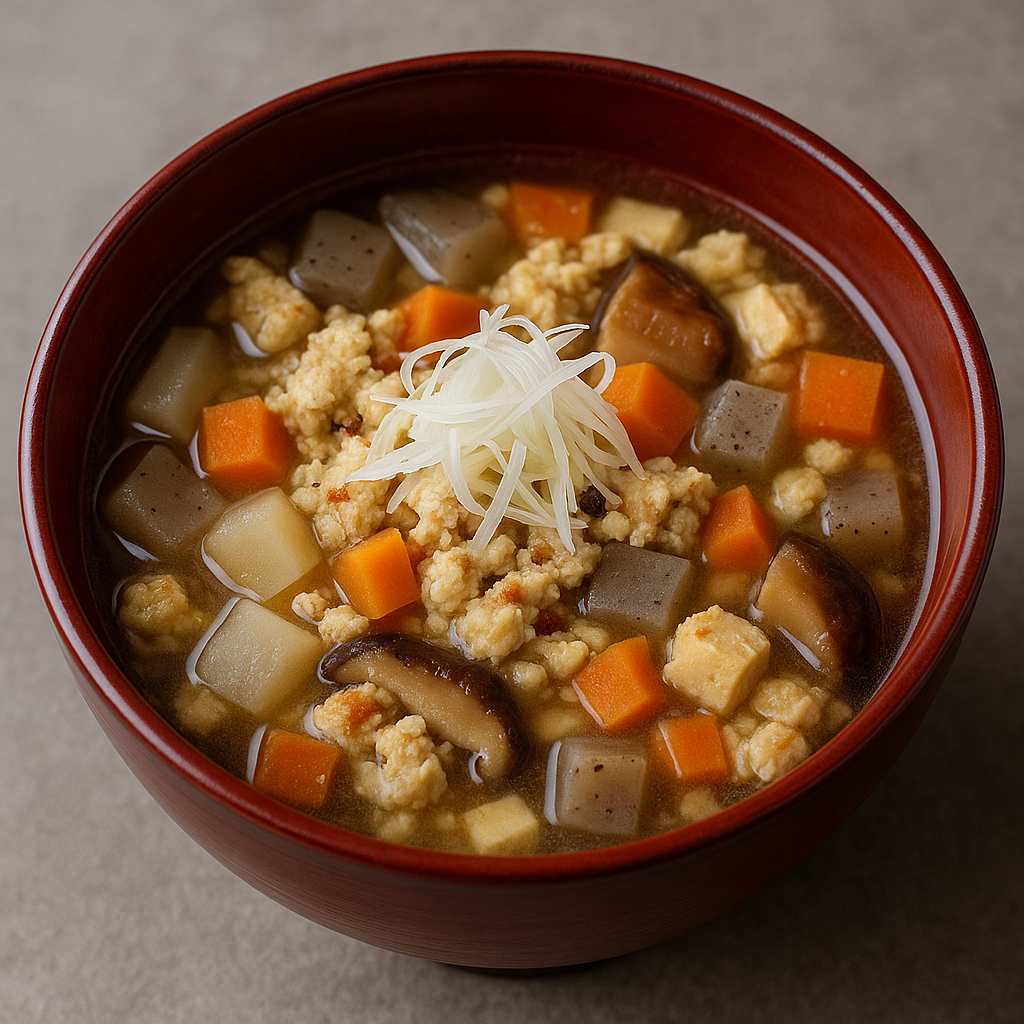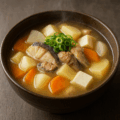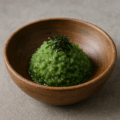けんちん汁(岩手)の特徴
根菜と豆腐の旨みを重ねる、香り立つしょうゆ仕立ての一椀
けんちん汁は、だしに大根・にんじん・ごぼう・こんにゃくなどの根菜と木綿豆腐を合わせ、しょうゆで整える郷土の汁物です。豆腐は手でちぎって炒ることで香ばしさが増し、だしにコクが広がります。
精進の椀が家庭に根づき、岩手らしい実だくさんに発展しました
寺由来の精進汁が各地に広がり、岩手では根菜をたっぷり使う実だくさんの一椀として定着しました。季節や家庭により具や味加減が変わり、行事や日々の食卓に親しまれています。
けんちん汁(岩手) レシピ
材料(5人分)
- 木綿豆腐 … 1丁(350〜400g・水切り)
- 大根 … 200g(さいの目切り)
- にんじん … 120g(さいの目切り)
- ごぼう … 100g(角切り・水にさらす)
- こんにゃく … 1枚(さいの目・下ゆで)
- 長ねぎ … 1/2本(白髪ねぎ)
- 干し椎茸 … 4枚(薄切り・戻し汁はだしに)
- だし … 1,000ml(昆布+干し椎茸の戻し汁/昆布+煮干しでも可)
- しょうゆ … 大さじ2〜3
- みりん … 大さじ1
- ごま油 … 大さじ1(炒め用)
- 塩 … 少々
作り方
- 1. 豆腐は水切りし、手で他の具材よりも少しだけ大きめにちぎる。
- 2. 鍋にごま油を温め、豆腐を入れて水分を飛ばすように炒りつけ、軽く色付いたら一度取り出す。
- 3. 同じ鍋でごぼう・大根・にんじん・こんにゃく・椎茸を炒め、油を回す。
- 4. だしを注ぎ、煮立ったらアクをとり、中火で10〜12分煮る。
- 5. 豆腐を戻し入れ、しょうゆ・みりんで調味。味を見て塩で整える。
- 6. 長ねぎを加えてひと煮し、火を止める。
シェフのワンポイントアドバイス
- 豆腐は手でちぎるとだしが絡みやすいです。炒りつけるひと手間で香ばしさが増します。
- しょうゆは途中と仕上げの二段で入れると香りが立ちます。塩は最後の微調整にとどめます。
栄養価(1人分の目安)
- エネルギー … 150〜230 kcal
- たんぱく質 … 8〜14 g(豆腐由来)
- 脂質 … 6〜10 g
- 炭水化物 … 12〜20 g
- 食物繊維 … 3〜6 g(根菜・椎茸由来)
歴史
禅寺の精進料理が源流です
豆腐と根菜を油でいため煮にする調理は、寺の精進の椀として伝わり、各地に広まりました。肉や魚を使わずとも満足感のある味わいが特長です。
岩手では“実だくさんの家の味”として受け継がれました
根菜やこんにゃくを多めにし、寒い季節の体を温める一椀として発展しました。だしや調味の違いで家庭ごとの味が生まれ、行事食・日常食の両方で親しまれています。
English Version
Features of Kenchin-jiru (Iwate)
A soy-scented bowl layering the umami of roots and tofu
Kenchin-jiru is a local soup that combines dashi with daikon, carrot, burdock, konnyaku, and firm tofu, finished with soy sauce. Hand-tearing and dry-frying the tofu first adds toasty notes and depth to the broth.
From temple fare to hearty home style in Iwate
Born from Buddhist temple cuisine, the soup spread across regions. In Iwate it evolved into a generously filled, root-forward bowl. Ingredients and seasoning vary by season and household, making it a favorite for daily meals and gatherings.
Kenchin-jiru (Iwate) – Recipe
Ingredients (Serves 5)
- Firm tofu … 350–400 g (well-drained)
- Daikon … 200 g (small dice)
- Carrot … 120 g (small dice)
- Burdock … 100 g (small dice; soak in water)
- Konnyaku … 1 sheet (small dice; parboiled)
- Long green onion … 1/2 stalk (finely shredded)
- Dried shiitake … 4 caps (thinly sliced; use soaking liquid)
- Dashi … 1,000 ml (kombu + shiitake soaking liquid, or kombu + niboshi)
- Soy sauce … 2–3 Tbsp
- Mirin … 1 Tbsp
- Sesame oil … 1 Tbsp (for sautéing)
- Salt … a pinch
Directions
- 1. Drain tofu and tear slightly larger than the vegetable pieces.
- 2. Heat sesame oil in a pot; add tofu and dry-fry to drive off moisture until lightly colored. Remove and set aside.
- 3. In the same pot, sauté burdock, daikon, carrot, konnyaku, and shiitake until lightly coated with oil.
- 4. Pour in dashi; once boiling, skim and simmer over medium heat for 10–12 minutes.
- 5. Return tofu; season with soy sauce and mirin. Taste and fine-tune with salt.
- 6. Add shredded green onion; give a brief simmer and turn off the heat.
Chef’s Tips
- Hand-torn tofu holds broth better; the pre-toasting step builds aroma and body.
- Add soy sauce in two stages—midway and at the finish—for lifted fragrance. Use salt only for final fine-tuning.
Nutrition (per serving, approx.)
- Energy … 150–230 kcal
- Protein … 8–14 g (from tofu)
- Fat … 6–10 g
- Carbohydrates … 12–20 g
- Dietary fiber … 3–6 g (from roots & shiitake)
History
Roots in Zen temple shojin cuisine
Stir-frying tofu and root vegetables before simmering originates in meatless temple fare. The appeal lies in aroma and broth rather than animal ingredients.
A “loaded” home soup in Iwate
With extra roots and konnyaku, the soup warms the body through cold seasons. Differences in stock and seasoning create distinct household signatures, beloved both for daily meals and festive tables.



何でも質問してください!